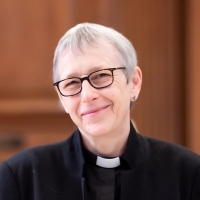Some years ago, I attended an art exhibition featuring the work of one of my former theological students. She had been a professional artist before she trained for ordination.
Among the exhibits, there was one sculpture by her that I found particularly startling. It was a figure of Mary, the mother of Jesus, shown crouching down, with a look on her face of such anguish that one could not help but find oneself drawn into her pain. Seeing my reaction the artist whose work it was came and stood behind me and, somewhat to my surprise, asked me: ‘What do you see?’
At which point I suddenly realized that I was not entirely sure quite what I was seeing, given the rather ambiguous pose of the figure. Was the anguish on the face of Mary the pain of a woman in labour, a woman in the process of giving birth, creating new life? Or was it the pain of a mother who has just seen her adult son nailed to a cross, and has watched him die a lingering and agonizing death? Was her agony the prelude to something joyful? Or was it a testimony to utter desolation and despair? Or was it both of those things? I wonder. I was reminded of the words from the closing section one of T.S. Eliot’s most famous poems, ‘Journey of the Magi’:
… were we led all that way
for Birth or Death? There was a Birth, certainly,
We had evidence and no doubt. I had seen birth and death,
But had thought they were different; this Birth was
Hard and bitter agony for us, like Death, our death.
The feast of Candlemas, the Presentation of Christ in the Temple, has a significance that can readily be overlooked. It is all too easy to regard it as little more than a rather cosy and convenient way of rounding off our celebration of Christmas and Epiphany with a very happy closing episode: in accordance with Jewish custom, the child Jesus is brought to the Temple to be presented to the Lord – and, there, he is recognized as the Messiah, the Saviour of Israel, by the aged Simeon, who greets him with rejoicing. So far, so good.
But there is far more to the Presentation in the Temple than that. In fact, there are three extremely important themes that today’s story invites us to reflect upon.
The first is a motif that I touched on in another sermon recently – namely that of recognition. At the birth of Jesus, the shepherds on the Bethlehem hillside had the assistance of a multitude of the heavenly host alerting them to the fact that the Messiah had arrived. The wise men from the East were conveniently provided with a star to lead them to the child. What makes today’s story distinctive is that, for Simeon and Anna, it was an encounter with the child himself that enabled them, instantly, to recognize him for who he truly was. I wonder what it was that they had glimpsed?
Recognition can be a strange and elusive thing to pin down. When my elder daughter, Sinéad, was very little I once overheard her playing with her dolls in a neighbouring room. They had clearly been very badly behaved little dolls because she was giving them one heck of a telling off. And I was perplexed by the fact that, in her choice of words, and phrases, and tone of voice, my little daughter sounded exactly like my mother. Perplexed because my mum was so far gone in early-onset dementia by the time Sinéad was born that she had never really known her. And then the chilling realization dawned: it was not in fact my mother that Sinéad was copying – it was of course me. I really was turning into my mother.
Such moments of recognition can be disarming in alerting us to a truth of which we were previously unaware. Sometimes it can take only a look, a gesture, a tone of voice – and the world suddenly becomes a different kind of place; and a previously hidden truth can be revealed in a way that is unexpected and sometimes very uncomfortable. And it was one of those powerful and life-changing moments of recognition that Simeon experienced.
The second important theme is, strangely enough, that of ‘incompleteness’. This is an interesting one. Simeon has waited all his life to greet the coming Saviour – and yet, having seen him, he is content to die – despite knowing that he himself will not live to see the promised salvation he has so yearned for, throughout all those years, becoming a reality. And there is something both noble and liberating about that.
I can remember once observing a parishioner of mine from a previous church planting bulbs in her front garden for the following Spring – an event that would have been wholly unremarkable, were it not for the fact that the woman in question knew that she was not expected to live for more than a few weeks. She knew perfectly well that she would not live to see those bulbs flower – and yet it mattered to her that others would enjoy them even after she had gone. Rather like the master architect of a great mediaeval cathedral, designing a building breathtaking in its scale and magnificence, who knows that he will not live to see his masterpiece completed because it will take decades to build. There is something beautiful about the quality of vision, and generosity of heart that says: ‘I will not live to see this myself, but I will do all that I can to create this gift for those who come after me. Alexander Solzhenitsyn once wrote a prayer that closes with these words:
and you will enable me to go on doing as much as needs to be done. And in so far as I do not manage it – that means that you have allotted the task to others.
The glory of incompleteness! – I find that a wonderfully liberating thought.
And the third theme encompassed by our story today takes us back to my opening story about that strangely ambiguous sculpture of Mary. Because the event that we celebrate today, the Presentation of Christ in the Temple, weaves together in ways that are subtly but inextricably linked, both joyful hope and forthcoming tragedy. Seeing the child Jesus, Simeon takes him in his arms and praises God, proclaiming him to be the promised Saviour of all, ‘A light to lighten the Gentiles, and the glory of God’s people, Israel’. But Simeon then turns his attention to Mary and adds this:
This child is set for the falling and rising of many in Israel, and for a sign that will be spoken against (and a sword will pierce through your own soul, also) so that the thoughts out of many hearts may.
And a sword will pierce through your own soul, also.
This is no ordinary child. This is a child whose coming brings with it judgement – the refiner’s fire; this is a child whose presence will bring to light the truth of what is written in human hearts – and the people whose inner lives, whose self-serving priorities, pride, and hardness of heart are exposed as a result, are not going to like it one bit. And the price of their resentment will be paid, not only by the Saviour himself, but also by the one who loved him more than anyone else: ‘and a sword will pierce through your own soul, also.’
The greatest joy in human life is the gift of love; but genuine loving demands costly things of us. Most challenging of all is the way in which it makes us vulnerable: vulnerable to rejection; and vulnerable to loss or bereavement; and the deeper our capacity to love the greater our ability to feel pain.
Candlemas, the feast of the Presentation in the Temple, marks the point at which our celebration of the coming of Christ into the world, through Christmas and Epiphany, finally comes to an end, and we turn our faces towards Lent. Today we can rejoice with every fibre of our being; we can rejoice as Simeon rejoiced, that God is with us; but we do so knowing that the road ahead will be difficult and challenging – because that is the nature of human life.
But ultimately, what draws us into that journey, and sustains us while we are on it, is love. A very particular kind of love; a love that was glimpsed by Simeon when he took the Christ child into his arms in the Temple; a love so powerful that it will never be afraid of engaging with the darkest things in life; a love that will ultimately and definitively conquer death.
And thanks be to God for a love that is as powerful, and as wonderful, and as glorious as that.
Amen.



